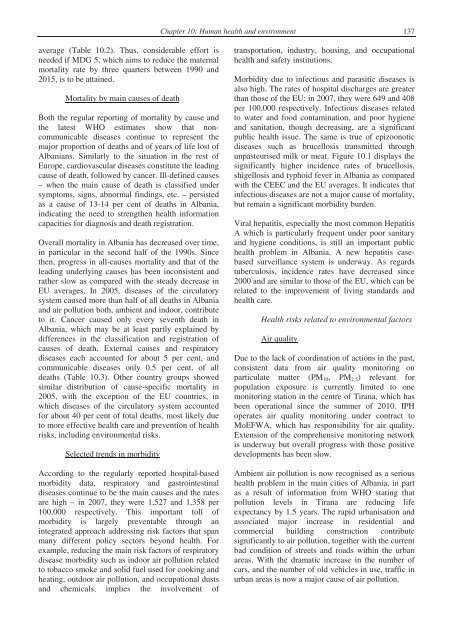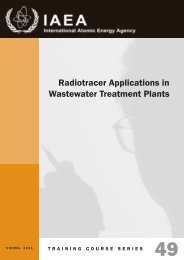Second Environmental Performance Review of Albania
Second Environmental Performance Review of Albania
Second Environmental Performance Review of Albania
You also want an ePaper? Increase the reach of your titles
YUMPU automatically turns print PDFs into web optimized ePapers that Google loves.
Chapter 10: Human health and environment137average (Table 10.2). Thus, considerable effort isneeded if MDG 5, which aims to reduce the maternalmortality rate by three quarters between 1990 and2015, is to be attained.Mortality by main causes <strong>of</strong> deathBoth the regular reporting <strong>of</strong> mortality by cause andthe latest WHO estimates show that noncommunicablediseases continue to represent themajor proportion <strong>of</strong> deaths and <strong>of</strong> years <strong>of</strong> life lost <strong>of</strong><strong>Albania</strong>ns. Similarly to the situation in the rest <strong>of</strong>Europe, cardiovascular diseases constitute the leadingcause <strong>of</strong> death, followed by cancer. Ill-defined causes– when the main cause <strong>of</strong> death is classified undersymptoms, signs, abnormal findings, etc. – persistedas a cause <strong>of</strong> 13-14 per cent <strong>of</strong> deaths in <strong>Albania</strong>,indicating the need to strengthen health informationcapacities for diagnosis and death registration.Overall mortality in <strong>Albania</strong> has decreased over time,in particular in the second half <strong>of</strong> the 1990s. Sincethen, progress in all-causes mortality and that <strong>of</strong> theleading underlying causes has been inconsistent andrather slow as compared with the steady decrease inEU averages. In 2005, diseases <strong>of</strong> the circulatorysystem caused more than half <strong>of</strong> all deaths in <strong>Albania</strong>and air pollution both, ambient and indoor, contributeto it. Cancer caused only every seventh death in<strong>Albania</strong>, which may be at least partly explained bydifferences in the classification and registration <strong>of</strong>causes <strong>of</strong> death. External causes and respiratorydiseases each accounted for about 5 per cent, andcommunicable diseases only 0.5 per cent, <strong>of</strong> alldeaths (Table 10.3). Other country groups showedsimilar distribution <strong>of</strong> cause-specific mortality in2005, with the exception <strong>of</strong> the EU countries, inwhich diseases <strong>of</strong> the circulatory system accountedfor about 40 per cent <strong>of</strong> total deaths, most likely dueto more effective health care and prevention <strong>of</strong> healthrisks, including environmental risks.Selected trends in morbidityAccording to the regularly reported hospital-basedmorbidity data, respiratory and gastrointestinaldiseases continue to be the main causes and the ratesare high – in 2007, they were 1,527 and 1,358 per100,000 respectively. This important toll <strong>of</strong>morbidity is largely preventable through anintegrated approach addressing risk factors that spanmany different policy sectors beyond health. Forexample, reducing the main risk factors <strong>of</strong> respiratorydisease morbidity such as indoor air pollution relatedto tobacco smoke and solid fuel used for cooking andheating, outdoor air pollution, and occupational dustsand chemicals, implies the involvement <strong>of</strong>transportation, industry, housing, and occupationalhealth and safety institutions.Morbidity due to infectious and parasitic diseases isalso high. The rates <strong>of</strong> hospital discharges are greaterthan those <strong>of</strong> the EU: in 2007, they were 649 and 408per 100,000 respectively. Infectious diseases relatedto water and food contamination, and poor hygieneand sanitation, though decreasing, are a significantpublic health issue. The same is true <strong>of</strong> epizoonoticdiseases such as brucellosis transmitted throughunpasteurised milk or meat. Figure 10.1 displays thesignificantly higher incidence rates <strong>of</strong> brucellosis,shigellosis and typhoid fever in <strong>Albania</strong> as comparedwith the CEEC and the EU averages. It indicates thatinfectious diseases are not a major cause <strong>of</strong> mortality,but remain a significant morbidity burden.Viral hepatitis, especially the most common HepatitisA which is particularly frequent under poor sanitaryand hygiene conditions, is still an important publichealth problem in <strong>Albania</strong>. A new hepatitis casebasedsurveillance system is underway. As regardstuberculosis, incidence rates have decreased since2000 and are similar to those <strong>of</strong> the EU, which can berelated to the improvement <strong>of</strong> living standards andhealth care.Health risks related to environmental factorsAir qualityDue to the lack <strong>of</strong> coordination <strong>of</strong> actions in the past,consistent data from air quality monitoring onparticulate matter (PM 10 , PM 2.5 ) relevant forpopulation exposure is currently limited to onemonitoring station in the centre <strong>of</strong> Tirana, which hasbeen operational since the summer <strong>of</strong> 2010. IPHoperates air quality monitoring under contract toMoEFWA, which has responsibility for air quality.Extension <strong>of</strong> the comprehensive monitoring networkis underway but overall progress with those positivedevelopments has been slow.Ambient air pollution is now recognised as a serioushealth problem in the main cities <strong>of</strong> <strong>Albania</strong>, in partas a result <strong>of</strong> information from WHO stating thatpollution levels in Tirana are reducing lifeexpectancy by 1.5 years. The rapid urbanisation andassociated major increase in residential andcommercial building construction contributesignificantly to air pollution, together with the currentbad condition <strong>of</strong> streets and roads within the urbanareas. With the dramatic increase in the number <strong>of</strong>cars, and the number <strong>of</strong> old vehicles in use, traffic inurban areas is now a major cause <strong>of</strong> air pollution.
















